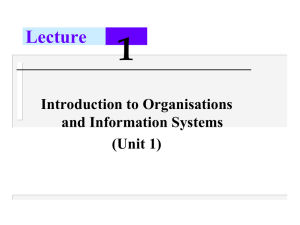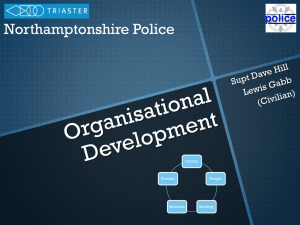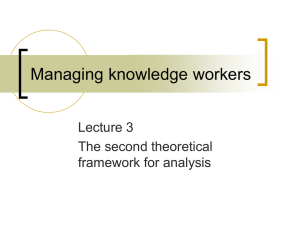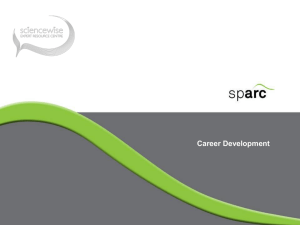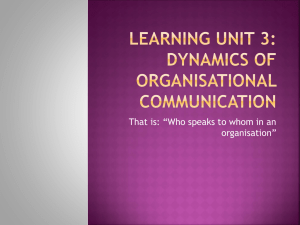Business Architecture - Assist Knowledge Development
advertisement
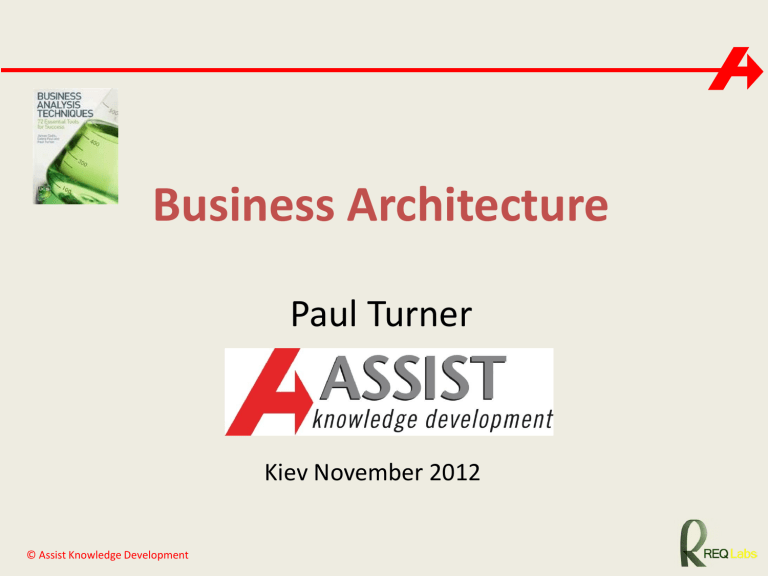
Business Architecture Paul Turner Kiev November 2012 © Assist Knowledge Development The breadth of Business Analysis Strategic analysis Business analysis Business case Requirements engineering Solution development © Assist Knowledge Development The breadth of Business Analysis Business Architecture Strategic analysis Business analysis Systems Thinking Business case Systems Modelling Requirements engineering Solution development © Assist Knowledge Development Agile development The breadth of Business Analysis Business Architecture Strategic analysis Business analysis Systems Thinking Business case Systems Modelling Requirements engineering Solution development © Assist Knowledge Development Agile development What is Architecture? © Assist Knowledge Development What is Business Architecture? “The structure and behaviour of a business system . Covering business functions or capabilities, business processes and the roles of the actors involved in these. Business functions and business processes are mapped to the business goals and business services they support, and the applications and data they need” "A blueprint of the enterprise that provides a common understanding of the organization and is used to align strategic objectives and tactical demands." Business Architecture Guild or simply: “The business strategy, governance, organization, and key business processes.” TOGAF © Assist Knowledge Development Uses of a Business Architecture • Develop a perspective on an organisation’s strategic/competitive differentiators, and fully understand what it is and what it is doing • Understand the key value streams used to deliver its value proposition • Provide a way to quickly and effectively implement strategy through defined approaches, processes and organisation wide frameworks • Make better-informed and more comprehensive business decisions • Solve complex enterprise business problems • Define detailed business needs, to be used as input for business and IT solutions • Ensure the success of an overall Architecture by serving as the driving force for the IT Architecture © Assist Knowledge Development Business Architecture in relation to other architectures © Assist Knowledge Development The impact of Business Architecture Consider the relationship with: • Strategy • Governance • Business Capabilities • Business Change © Assist Knowledge Development Focuses on WHAT the business needs to do F rather than HOW it does it Business Architecture fit within an organisation Creates a direct, clear linkage between executive intent and organisational action Strategy drives changes to Architecture Strategy Architecture translates Strategy for Execution Architecture Architecture informs and refines Strategy Execution Execution enables and generates improvements to Architecture Provides a structured approach to making strategic and operational investment decisions © Assist Knowledge Development Systemic change Systemic change is one where the impact of any change is considered in respect of the whole ,and the relationships between the individual parts to one another i.e. see the bigger picture © Assist Knowledge Development Cause and effect The solution to one problem may cause another bigger Problem We may act to produce short term benefits leading to long term costs © Assist Knowledge Development The role of the Business Architect The Business Architect converts high-level business strategy and business needs ……. ……. into an integrated vision of the future ……. and then redesigns the business capabilities necessary to deliver the goals of the vision. This provides a holistic, complete and co-ordinated set of business models the best of which become roadmaps for future profit and growth. These roadmaps can then broken down into initiatives for implementation © Assist Knowledge Development Aspects of a Business Capabilities Organisation Information Value Streams Source: Business Architects Guild © Assist Knowledge Development Aspects of a Business Customers, Partners & Competitors Policies, Rules, Regulations Capabilities Organisation Products & Services Information Value Streams Metrics & Measures Business Architecture Source: Business Architects Guild © Assist Knowledge Development Vision, Strategies & Tactics Initiatives & Projects Decisions & Events POPIT™ – taking a holistic approach Business Motivations Organisation Information & Technology People Processes Business Architecture Blueprints © Assist Knowledge Development POPIT™ – taking a holistic approach Business Models External Business Environment Organisational Capabilities Organisational Memory Organisation Information & Technology People Processes Business Architecture Blueprints © Assist Knowledge Development POPIT™ – taking a holistic approach Business Models External Business Environment Organisational Capabilities Organisational Memory Organisation Information & Technology People Processes Business Architecture Blueprints © Assist Knowledge Development Value Propositions Value Chains Core Business Processes Business Services POPIT™ – taking a holistic approach Business Models External Business Environment Organisational Capabilities Organisational Memory Organisation Roles and Job Descriptions Skills and Competencies Management Activities Culture Communication Information & Technology People Processes Business Architecture Blueprints © Assist Knowledge Development Value Propositions Value Chains Core Business Processes Business Services POPIT™ – taking a holistic approach Business Models External Business Environment Organisational Capabilities Organisational Memory Business Information Models Information Standards Technical Architecture Application Architecture Organisation Roles and Job Descriptions Skills and Competencies Management Activities Culture Communication Value Propositions Value Chains Core Business Processes Business Services Information & Technology People Processes Business Architecture Blueprints © Assist Knowledge Development Business Architecture scenarios Example business scenarios might include: • • • • • • • • Mergers and acquisitions Business unit consolidation New product deployment New line of business Outsourcing of a business capability Regulatory compliance Divesting a line of business Implementing a new way of working © Assist Knowledge Development Business Architecture Framework Business Motivations Business Architecture Scenarios Business Architecture views (Blueprints) © Assist Knowledge Development Examples of Business Architecture documentation • Business Context • Business glossary of terminology and concepts • Business capabilities (represented in a Business Capability Model) • Detailed Business Capabilities (Business Requirements) • High level business processes (often represented in a value stream model) • More detailed business processes and workflows • Organisational units and roles • Business rules • Business data elements and metrics © Assist Knowledge Development So how does this effect Requirements Engineers? • To contribute to the bottom-up construction of the Business Architecture • Help evaluate business ideas and initiatives • Assess impact of suggested changes • Encourage re-use • Model using architecture artefacts • Understand knock-on effects of change • Ensure changes are reflected back into the architecture © Assist Knowledge Development Business Architecture Paul Turner paul.turner@assistkd.com © Assist Knowledge Development





